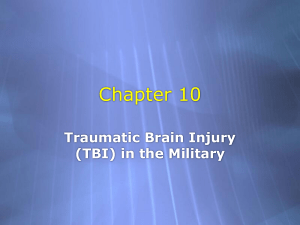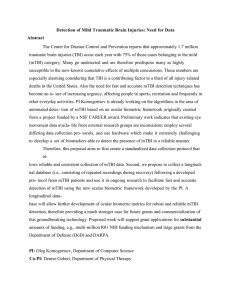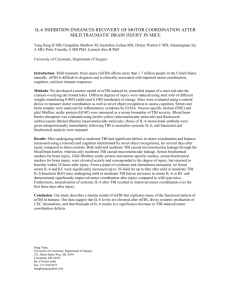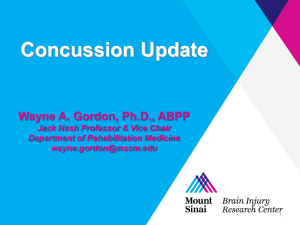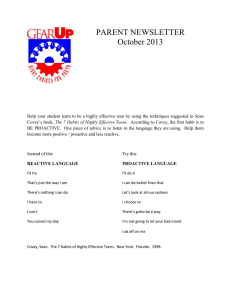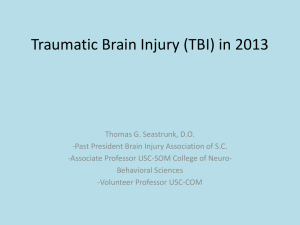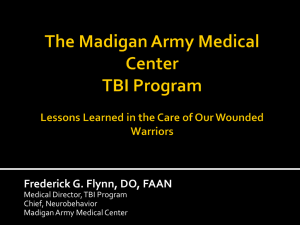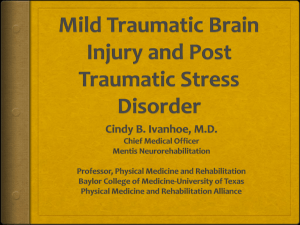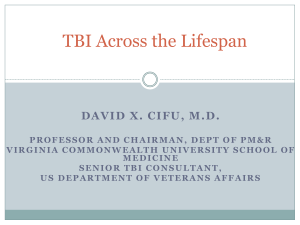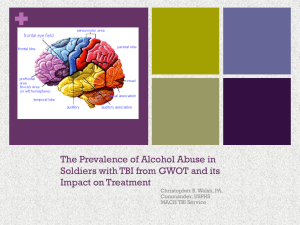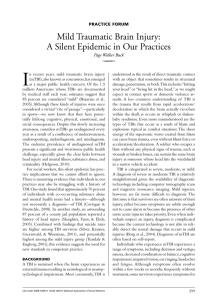Mild Traumatic Brain Injury - UCI Department of Emergency Medicine
advertisement
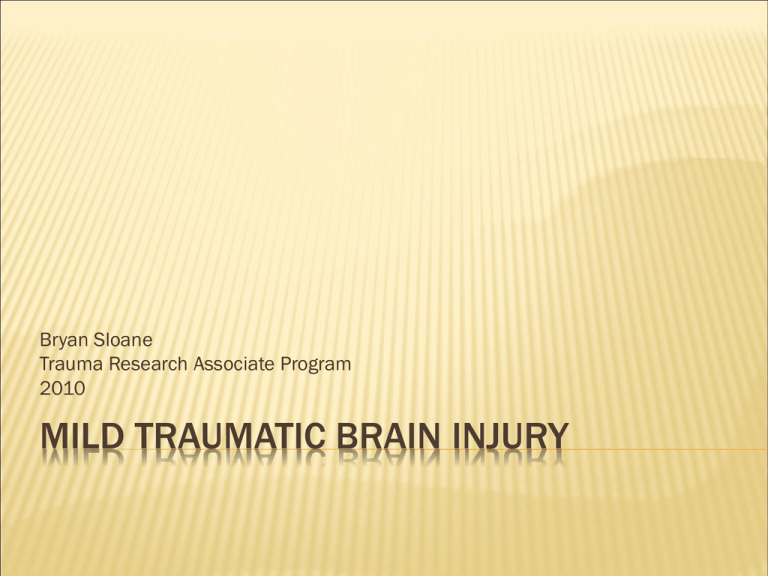
Bryan Sloane Trauma Research Associate Program 2010 MILD TRAUMATIC BRAIN INJURY BRAIN ANATOMY MILD TRAUMATIC BRAIN INJURY Also more commonly known as a Concussion Differs from Cerebral Contusion Very common in contact sports Acute but transient effects Emotional, physical and cognitive effects Frequent MTBIs can add to each other, causing cumulative brain damage Loss of brain function, similar to a petite mal Sz MECHANISM OF INJURY Injury to a portion of the brain resulting from rapid acceleration or deceleration of the brain Impact against the skull causes edema and loss of functionality Damage can last from hours to weeks Neurotransmitters released in excess as a result of injury (mechanical depolarization) ->Causes deregulation of membrane potential and unfocused depolarization -> ATPase pumps (Na/K) work in excess to restore balance ->Cells become hypermetabolic, and Glucose levels can be depleted. Decreased cerebral blood flow adds to this effect and can create long lasting damage. Axonal damage can occur due to stretching or sheering of the neuronal Axons when they experience the force (DIA) SYMPTOMS Confusion/ disorientation/ amnesia/ emotional changes LOC Headache, Dizziness, vomiting, nausea Lack of motor coordination Audio/visual disturbances Tinnitus Convulsions MTBI SCALE AND CLINICAL SCALES MTBI can be broken down into three categories as defined by the American Academy of Neurology Guidelines Grade I Grade II Confusion and disorientation with symptoms lasting more than 15 mins Grade III Loss of Consciousness Confusion, no LOC and symptoms last less than 15 mins IIIa LOC lasts seconds IIIb LOC last for minutes EEGs obtained after concussive injury in animal models show the same electrical activity as generalized Sz activity (confusion is similar to postictal state after a Sz) Clinically measured using Glasgow Coma Scale and A&Ox4 questions Person, Place, Time, Event GLASGOW COMA SCALE MTBI usually presents with high GCS Confusion and disorientation could present at 14 TREATMENT Mortality is very low, but repeated MTBI can cause long term damage with the injury increasing in severity with each successive incident Most of the time observation and non ASA analgesics are used. Trauma patients are frequently observed until other factors that could mask a more severe Brain Injury wear off (sedation, drugs, EtOH) Most of the time there are no structural changes visible on a head CT. COMPLICATIONS Cumulative effects Increased risk of Alzheimer’s disease and memory problems Second-impact syndrome Fatal in many cases Occurs when a second minor blow to the head is experienced after a recent MTBI Could be due to Blood Vessels in the brain losing the ability to regulate blood flow and ICP rapidly increases. EPIDEMIOLOGY Of the 1.4 million who sustain a TBI each year in the United States: Among children ages 0 to 14 years, TBI results in an estimated: 2,685 deaths; 37,000 hospitalizations; and 435,000 emergency department visits annually.1 The leading causes of TBI are: 50,000 die; 235,000 are hospitalized; and 1.1 million are treated and released from an emergency department.1 Falls (28%); Motor vehicle-traffic crashes (20%); Struck by/against events (19%); and Assaults (11%).1 $60 Billion in costs to the US yearly SOURCE MATERIAL http://www.cdc.gov/ncipc/tbi/TBI.htm Shaw, Nigel. "The neurophysiology of concussion." Progress in Neurobiology 67.4 (2002): 281-344. Print. http://studentlanka.com/images/brain-insideskull.jpg http://www.pollsb.com/photos/o/57124ever_concussion.jpg
